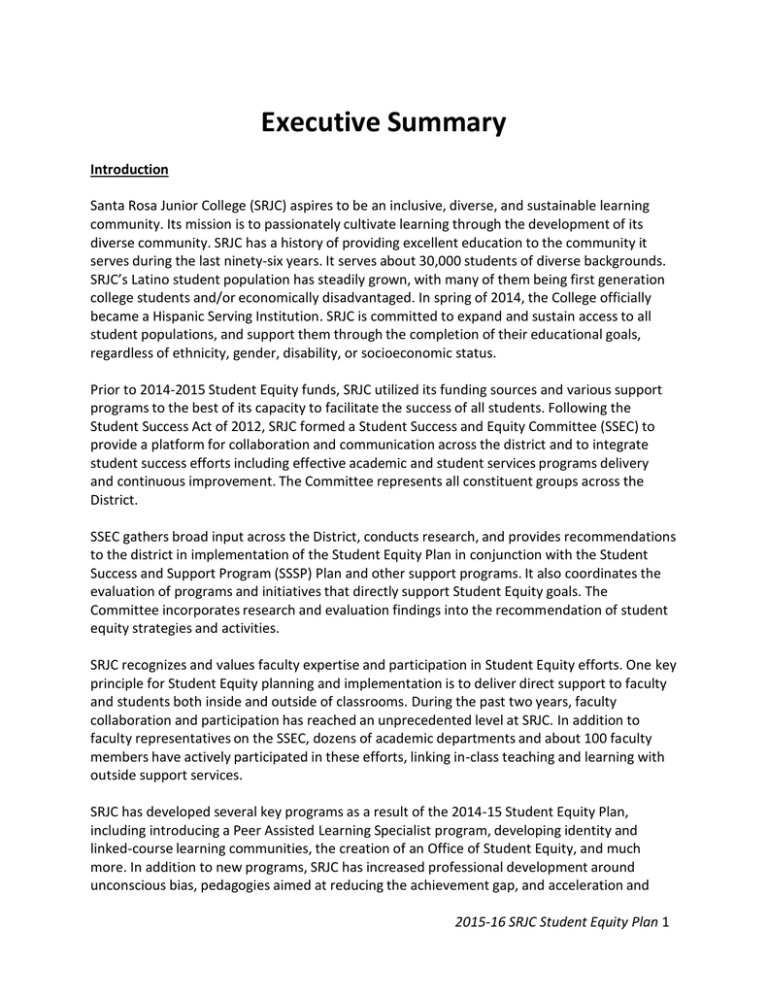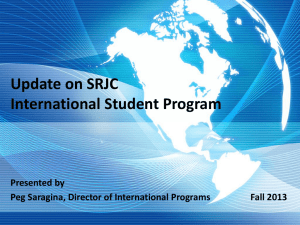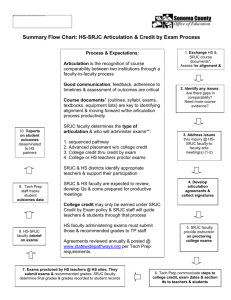Executive Summary
advertisement

Executive Summary Introduction Santa Rosa Junior College (SRJC) aspires to be an inclusive, diverse, and sustainable learning community. Its mission is to passionately cultivate learning through the development of its diverse community. SRJC has a history of providing excellent education to the community it serves during the last ninety-six years. It serves about 30,000 students of diverse backgrounds. SRJC’s Latino student population has steadily grown, with many of them being first generation college students and/or economically disadvantaged. In spring of 2014, the College officially became a Hispanic Serving Institution. SRJC is committed to expand and sustain access to all student populations, and support them through the completion of their educational goals, regardless of ethnicity, gender, disability, or socioeconomic status. Prior to 2014-2015 Student Equity funds, SRJC utilized its funding sources and various support programs to the best of its capacity to facilitate the success of all students. Following the Student Success Act of 2012, SRJC formed a Student Success and Equity Committee (SSEC) to provide a platform for collaboration and communication across the district and to integrate student success efforts including effective academic and student services programs delivery and continuous improvement. The Committee represents all constituent groups across the District. SSEC gathers broad input across the District, conducts research, and provides recommendations to the district in implementation of the Student Equity Plan in conjunction with the Student Success and Support Program (SSSP) Plan and other support programs. It also coordinates the evaluation of programs and initiatives that directly support Student Equity goals. The Committee incorporates research and evaluation findings into the recommendation of student equity strategies and activities. SRJC recognizes and values faculty expertise and participation in Student Equity efforts. One key principle for Student Equity planning and implementation is to deliver direct support to faculty and students both inside and outside of classrooms. During the past two years, faculty collaboration and participation has reached an unprecedented level at SRJC. In addition to faculty representatives on the SSEC, dozens of academic departments and about 100 faculty members have actively participated in these efforts, linking in-class teaching and learning with outside support services. SRJC has developed several key programs as a result of the 2014-15 Student Equity Plan, including introducing a Peer Assisted Learning Specialist program, developing identity and linked-course learning communities, the creation of an Office of Student Equity, and much more. In addition to new programs, SRJC has increased professional development around unconscious bias, pedagogies aimed at reducing the achievement gap, and acceleration and 2015-16 SRJC Student Equity Plan 1 curriculum improvement exploration. We have also improved outreach coordination and awareness of disproportionate impact and achievement gaps campus-wide. The 2015-16 plan builds on this success, and utilizes both concentrated support strategies alongside widespread engagement. The 2015-16 plan includes a larger number of course completion activities. Course completion is a priority for SRJC because retention is the first step towards achieving academic goals. By ensuring that students are retained in their courses and have high quality learning experiences, we are striving to influence the entire academic pathway for historically underrepresented students. Research Methodology SRJC utilized the Proportionality Methodology to identify disproportionately impacted students. This method compares the percentage of a disaggregated subgroup in an initial cohort to its own percentage in the resultant outcome group. The formula for proportionality is the percentage in the outcome group divided by the percentage in the original cohort (outcome percentage/cohort percentage). The Proportionality Index charts are color coded to help easily identify DI groups for each Success Indicator. The intensity of the corresponding color is an indication of the gap between the value of the index and the number one. Proportionality Index 1.0 Less Than 1.0 More Than 1.0 Interpretation Proportions of subgroups are equal. Subgroup is less prevalent in the outcome group. Subgroup is more prevalent in the outcome group. Color key for the Proportionality Index 0………………………………..……….1……………………………………….2+ Following the recommended methodology provided in the CCCCO template, the SRJC Office of Institutional Research calculated the “number of students ‘lost’” and provided it in the target population charts for each Success Indicator. This is the number of students who, if they had succeeded, would bring the Proportionality Index for the selected sub-group to value one. The resulting formula yields the results that are identical to the results obtained via Percentage Gap methodology if the size of the sub-groups are significantly smaller than the size of the entire student cohort, which is true for all the subgroups we identified here. Based on the research of Bensimon and Malcom-Piqueux (2014), the CCCCO template recommended that students experiencing disproportionate impact be defined as those with a Proportionality Index of 0.85 or less. In general SRJC used this benchmark to guide our activities and planning. However, based on local research data and demographics, in a few cases we identified subgroups with indexes between 0.85 and 0.99 as disproportionately impacted to better reflect the needs of our student population. 2015-16 SRJC Student Equity Plan 2 Target Groups The following groups of students have been identified as being disproportionally impacted for one or more of the success indicators at SRJC: African Americans Latinos Pacific Islanders/Filipinos Native Americans Students with disabilities Economically disadvantaged students Foster Youth First generation students Goals Over the next year, SRJC’s Student Success and Equity Committee will continue refining the goals for each target population. This will include examining integration with SRJC’s institutional planning and effectiveness effort, facilities master planning process, master plan for education, and other institutional processes as well as researching standards in higher education and peer institutions. Through integrated data collection and planning informed by the SE Indicators, it is our hope that each of the SRJC plans will have similar goals to leverage our efforts and ensure collaboration. SRJC has identified an ambitious overall goal for reducing the achievement gap in each indicator by 20 percent by 2020. This goal of reducing DI by 20 percent and this Equity Plan will serve as a framework for ongoing discussion, action, and evaluation of our efforts to ensure equitable student success at SRJC. Activities by Success Indicator Access Improve the coordination of outreach efforts. Build on the Day under the Oaks and Jesse Peter Museum programs to develop specialized activities for Native American Students. Provide a one-stop Dream Center for undocumented students. Support a Veteran’s center with expanded programming in Petaluma. Research and develop programming for Adult Re-entry programs. Shone Farm Transportation Course Completion Offer and expand the Peer Assisted Learning Specialist program (PALS). Develop and analyze a survey of Native American students at SRJC to identify barriers and interventions to retention and success. Support the Foster Care and Kinship Education Programs with additional staff and services. Expand the Library Textbook Loan Program. Provide Smarthinking Online tutorial services. 2015-16 SRJC Student Equity Plan 3 Implement and support Identity-based Learning Communities. Provide targeted tutoring for athletic department. SRJC High School Math and English Curriculum Alignment with Common Core. ESL / Basic Skills Provide a Vocational Skills Coach for the DRD College to Career Program. Support Linked-course Learning Communities. Provide embedded counseling visits to Basic Skills classes. Strengthen pathways from noncredit to credit by improving services at the Southwest Center. Expand hours at the Petaluma Tutorial and Writing Center. Host department orientations for new adjunct faculty in College Skills, English, and ESL. Degree / Certificate Develop and implement a Guided Pathways to Degree Completion program. Explore and develop accelerated Math sequence and success. Provide dedicated counseling for MESA and HSI learning communities. Transfer Implement a comprehensive transfer package including a Program Specialist I, Equity Transfer Counselor, and expanded programming. Support the Math, Engineering, Science, Achievement (MESA) program with additional staff. Multiple Indicators Develop and pilot a Middle School Early Success Program. Develop and support an “Our House” Multicultural Center at the Petaluma campus. Provide comprehensive support to all Student Equity programs through the development of an Office of Student Equity. Develop and implement a comprehensive District-wide professional learning program aimed at supporting the goals and activities in the Student Equity plan. Facilitate Action Research groups to further explore the achievement gaps and interventions for target populations, including LGBT, minority men, and adult learners. Provide direct student support to target populations, this may include book vouchers, food vouchers, transportation, child care, supplies, permit and certificate application support, student conferences, and uniforms. Provide Student Health Services support for target populations. Expand Library Hours. 2015-16 SRJC Student Equity Plan 4 Activities by SRJC Strategy Funding Sources Under the guidelines of District Strategic Planning, Santa Rosa Junior College utilizes a Program Review and Planning Process (PRPP) to evaluate program effectiveness and to allocate resources (funds, staffing, and facilities). These planning components inherently fulfill, advance, and advocate for Student Equity as part of the institutional responsibility. SRJC will utilize funds from multiple sources to support its equity goals. The sources of funding which have been and/or will be used for Student Equity include: District General Fund Extended Opportunity Programs and Services Fund Student Equity Fund CalWORKS Fund Basic Skills Initiative Fund Associated Students Fund Board of Governors Financial Assistance Program Fund Student Health Fee Fund Grant Funds: Gateway to College, Student Success and Support Program Fund College to Career, Foster Youth, Hispanic Serving Institution Disabled Student Program and Services Fund SRJC Foundation Funds 2015-16 SRJC Student Equity Plan 5 Contact Persons Li Collier, Dean of Student Success, Equity, and Retention Phone: 707.524.1797 Email: lcollier@santarosa.edu Genevieve Bertone, Director, Student Equity Phone: 707.521.7925 Email: gbertone@santarosa.edu 1501 Mendocino Avenue Santa Rosa, CA 95401



